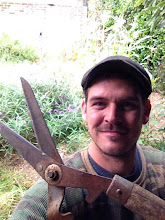 {Originally Posted 03/25/08}
{Originally Posted 03/25/08}The following is brought to us from Jimi, my roommate and fellow gardener:
Vermiculture is an excellent way to turn household food scraps and paper products into usable nutrients for indoor and outdoor plants alike. The worms can be purchased at gardening stores as well as at bait shops or online. Red wigglers or red earthworms are best. We got ours off of craigslist. If you know of anyone who does vermiculture, I guarantee they have a few hundred extra worms they can spare and some enthusiasm about the topic. It combines chemistry, recycling and most important, nearly instantaneous gratification.
Getting Started
Ingredients:
Several hundred worms
A 3” layer of shredded paper
A handful of food scraps
A handful of garden soil
Procedure:
1.Combine soil, food scraps and worms in
your container.
2.Add a layer of paper
3. Moisten with water, approx. a cup. Love.
4.Wait several weeks
Seriously, that’s all there is to it.
Maintenance should be done ever one or two weeks. The ingredients should be remixed and a fresh layer of paper should be added to the pile along with another handful of food scraps and a few more tablespoons of water depending on moisture. Worms love to eat melon rinds, paper, coffee grounds with filter, veggie and fruit scraps. Worms are less than amorous about waxy paper from magazines, meat, dairy, oil, citrus, onions, and garlic. Experiment your little heart out. It’s fun to see what they will and will not eat.
Healthy worm compost smells like, believe it or not, a forest floor, or like that just rained on smell, it’s earthy but not overpowering. I am not being overly romantic even though I may or may not have a picture of my worms in my wallet.
Troubleshooting
Smelly Bin- Worms are vegan. This means that no animal products including butter, cheese, any meat should be added to compost unless you like maggots. As a friend of mine who put shrimp shells into the pile pointed out. “They’re maggots, they fuck, they fly away and then they never come back. What’s the big deal?” The deal is it is smelly and never completely breaks down.
Undigested Scraps- Worms do not care for things such as onions, garlic, or citrus. You can do your own experiments but I assure you these things are less likely to break down. Basically, they do not enjoy too much acidity in their diet.
Too wet- Some bins have a drainage system to allow for run off that can be used as a version of compost ‘tea.’ However, more paper should do the trick. A decreased rate of food scrap additions may also do the trick until it corrects itself.
Escaping worms- If your worms are climbing up the walls of the bin, they are not happy inside. They are not getting something they need. Let’s imagine that worms are like any person, you or me, after a serious night of drinking. They are completely hungover! Mostly what they need is more peace and covered quiet. Vibration, radical changes in temperature and/or humidity, or too much light could all be factors. Sometimes all it takes as a thicker layer of paper scraps to ensure they have a layer between themselves and the harsh reality of the outside world, like a thick comforter separating daylight from your fragile, hungover pupils.
Too dry- Add water.
Too many worms-No such thing. As miraculous as it may seem this asexual bunch of fuckers keep their own population in check based upon resources. If only humans could do the same, right?
Harvesting
Basically, when there is nothing left but shit, ahem! worm castings, you can harvest. The castings form balls of silky, deep cocoa that can be broken up and spread into soil for amending. In addition you can make worm 'tea’ either by draining off extra moisture from the bottom of the bin or by placing a ball into a watering can and then watering the plants. It is excellent all around poop, I mean fertilizer. I never wait and I harvest as I go. You can place a sieve or use a tray system if you want to get fancy and not get your hands dirty but I think it is sort of part of the fun.
 For more advice and a really silly diagram of a worm bin, check out: Worm Bin Diagram
For more advice and a really silly diagram of a worm bin, check out: Worm Bin DiagramThanks Jimi! I couldn't have said it better myself!






